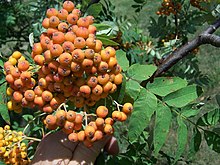Sorbus americana
| American mountain-ash | |
|---|---|
 |
|
| Scientific classification | |
| Kingdom: | Plantae |
| (unranked): | Angiosperms |
| (unranked): | Eudicots |
| (unranked): | Rosids |
| Order: | Rosales |
| Family: | Rosaceae |
| Genus: | Sorbus |
| Section: | Commixtae |
| Species: | S. americana |
| Binomial name | |
|
Sorbus americana Marshall |
|
| Synonyms | |
The tree species Sorbus americana is commonly known as the American mountain ash. It is a deciduous perennial tree, native to eastern North America.
The American mountain ash and related species (most often the European mountain ash, Sorbus aucuparia) are also referred to as rowan trees.
Sorbus americana is a relatively small tree, reaching 12 metres (40 ft) in height. The American mountain-ash attains its largest specimens on the northern shores of Lake Huron and Lake Superior.
It resembles the European mountain-ash, Sorbus aucuparia.
Native to eastern North America;
The berries of American mountain-ash are eaten by numerous species of birds and small mammals, including ruffed grouse, ptarmigans, sharp-tailed grouse, blue grouse, American robins, other thrushes, waxwings, jays, squirrels, and rodents.
American mountain-ash is a preferred browse for moose and white-tailed deer. Moose will eat foliage, twigs, and bark. Up to 80 percent of American mountain-ash stems were browsed by moose in control plots adjacent to exclosures on Isle Royale. Fishers, martens, snowshoe hares, and ruffed grouse also browse American mountain-ash.
Sorbus americana is cultivated as an ornamental tree, for use in gardens and parks. It prefers a rich moist soil and the borders of swamps, but will flourish on rocky hillsides.
A cultivar is the red cascade mountain ash, or Sorbus americana 'Dwarfcrown'. It is planted in gardens, and as a street tree.
...
Wikipedia
